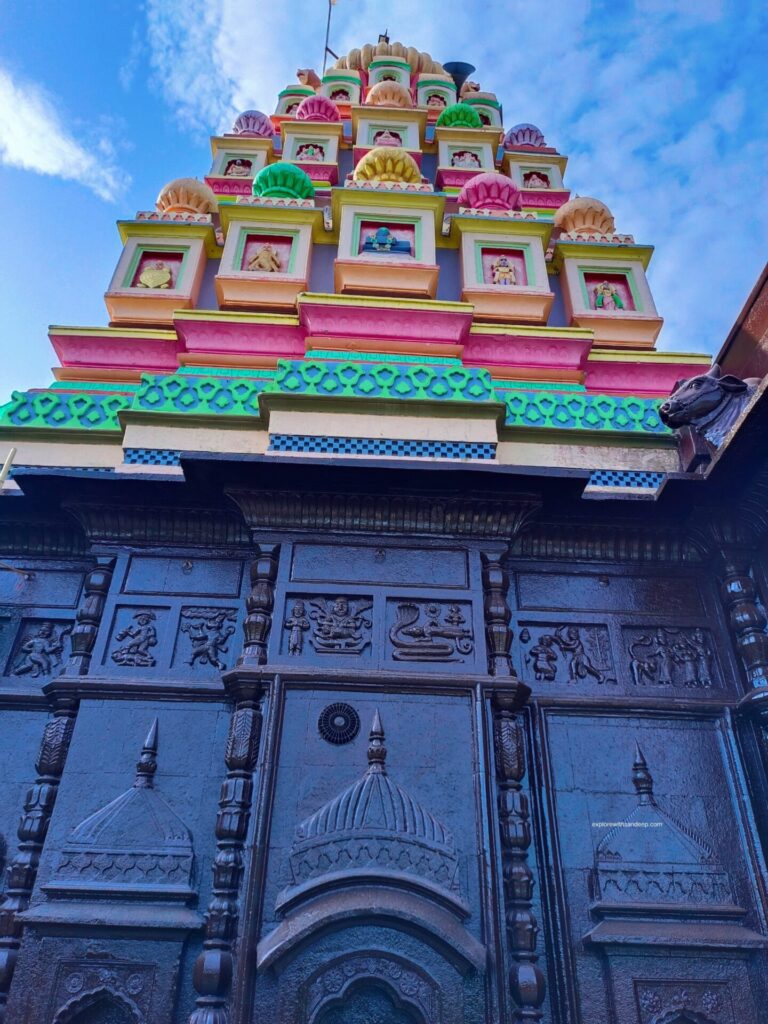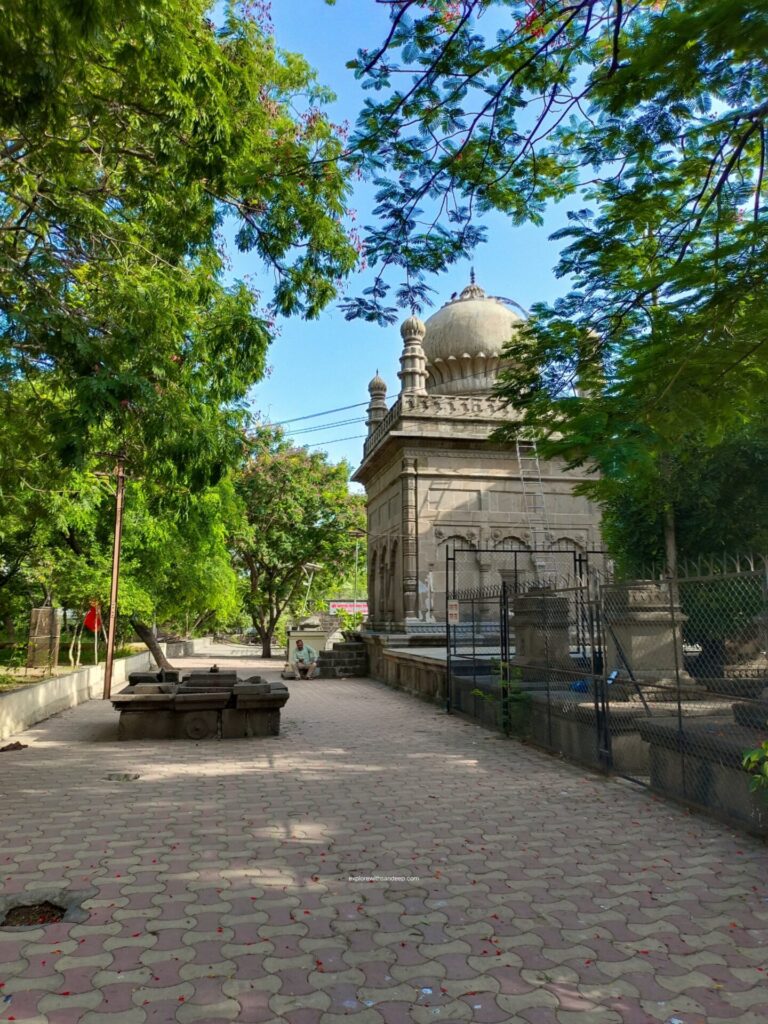wagheshwar temple, wagholi

The Wagheshwar Temple is a Hindu temple dedicated to Lord Shiva, located in the village of Wagholi, 16 km from Pune city. Pilajirao Jadhav, a prominent warrior who played a major role in the expansion of the Maratha Empire, was the driving force behind the development of Wagholi. He constructed many temples in the village, including the Ram Mandir and Hanuman temples, with the most notable being the Wagheshwar Temple. Situated on the main Pune-Ahmednagar Highway, this temple is easily visible from the road and is set beside a picturesque lake.
Exploring wagheshwar temple


While riding on Pune-Ahmadnagar road, this temple caught my attention. It’s easily visible from the main road with a prominent sign of Shiv Shambho and a trishul between the words. On the backside, there’s a beautiful lake beside the temple. Intrigued, my friend Nitin and I decided to visit, capturing some photos beforehand.


Upon reaching a signal, we turned left and arrived at what seemed like the temple’s parking area. However, we were informed by a local shopkeeper that parking was not allowed there. He directed us to park on the opposite side of the road. Near the temple, there were many small shops offering street food and various items, catering to hungry visitors. Local vendors also sold flowers and puja materials.


Approaching the main entry gate of Wagheshwar Temple, we noticed its grandeur, with “Shri Wagheshwar Mandir” written on it. A notice board at the gate caught my attention, clearly stating a dress code for entering the temple. This was an unusual sight for me, as such rules are not commonly highlighted in all temples. It made me think about how many people visit temples nowadays primarily for social media posts rather than spiritual reasons. Seeing this, I thought that such a dress code should be made mandatory for all temples to maintain sanctity and respect. This dress code warning was prominently displayed by the Wagheshwar Temple trust.

Inside the temple premises, the atmosphere was serene, surrounded by large trees and a small garden. A board nearby displayed information about the temple’s opening hours and the timing of Aarti.

As I entered, I came across a small temple dedicated to Lord Shiva, with a statue of Nandi placed outside, facing towards the temple. The entry gate was modest, so my friend and I took blessings outside and moved forward.


Nearby, there was a large black Deepmala, seemingly recently constructed, which lights up during festivals. From there, we had a clear view of the Wagheshwar Temple. To the right of the temple, there was a shoe stand where we left our footwear before proceeding further.


Approaching the small entry gate with “Om Namah Shivay” written above, we noticed a large bell hanging that added to the temple’s charm. In front of the temple, a large statue of Nandi was placed inside a pavilion, with smaller statues of Nandi’s face on all four sides, offering a divine experience to devotees. After seeking blessings from Nandi, we moved towards the main temple entrance.


To the right, there was an idol of Lord Ganesha, and to the left, an idol of Lord Hanuman. We took blessings and proceeded inside the temple.


Inside, the temple was adorned in a beautiful golden yellow color, with intricately carved pillars enhancing its beauty. Just inside the door, there was a turtle idol, and beyond that, another gate led to the sanctum where the Shivling was housed. This inner gate was exquisitely carved and silver-coated, with a small silver idol of Lord Ganesha and a depiction of a demon’s face at the bottom.

Upon entering, we felt surrounded by a peaceful and divine atmosphere. In the center of the sanctum sanctorum (garbhagruh), there was a Swayambhu Mahadev Shivling, decorated with golden-colored metal bars inscribed with “Om Namah Shivay.” Near the Shivling was a trishul with a damru and a kamandalu (water pot), from which water continuously flowed onto the Shivling.



The garbhagruh’s dome was lit up with yellow LED lights, further enhancing its beauty. At one corner, an oil lamp burned with an idol of Nataraj nearby, while on the right side, a small trishul with a damru was placed.
My friend Nitin and I received blessings from Lord Mahadev and sat for a while, enjoying the peace and energy of the place. After some time, we exited the temple and began exploring the surroundings.



The temple’s lower part was in black, contrasting with the colorful kalash on top adorned with carvings of various deities such as Lord Shiva, Lord Rama, Lord Hanuman, Devi Saraswati, Mahaveer, and others. The outer walls of the temple were beautifully carved with statues of gods, including the ten avatars of Lord Vishnu like Vamana, Narasimha, Krishna, and Rama. Behind the temple, there was an entry point to a lake, where visitors could take boat rides and enjoy a scenic view of Wagheshwar Temple. Adjacent to the lake was a small garden known as Nana-Nani Park.


Near this park, a mandap-like structure was built for visitors to sit and enjoy the beautiful view of Wagheshwar Temple with the lake in the background. Inside this mandap, glass boxes housed statues of Saint Dnyaneshwar, Saint Tukaram Maharaj, and Lord Vitthal with Rukmini. Carvings on the walls depicted the stories of the Warkari community of Maharashtra.After relaxing for 10 minutes in these serene surroundings, we set out to explore more around the temple.
Subhedar Pilajirao Jadhavrao Samadhi




Subhedar Pilajirao Jadhavrao history
Pillajirao Jadhav, born in 1680 and passing away on July 3, 1751, was a respected military leader in the Maratha Empire during Chhatrapati Shahu Maharaj’s rule. He came from a notable Maratha family and played crucial roles in many battles and campaigns that helped the empire grow and defend itself against enemies like the Mughals. He was known for his smart strategies and bravery, especially when rescuing important leaders from captivity. Jadhav also taught martial arts to Bajirao Peshwa and was involved in significant expeditions and campaigns across India for fifty years. His loyalty, courage, and leadership left a lasting mark on Maratha history.
continuing the Exploration



During our exploration, we came across the samadhi of Sardar Pillajirao Jadhav, a renowned warrior whose valor played a vital role in the expansion of the Maratha Empire. Pillajirao Jadhav resided in Wagholi village, and paying our respects at his samadhi was a humbling experience.
Next to Sardar Pillajirao Jadhav’s samadhi, we noticed several smaller samadhis, though their identities were unspecified as no names were mentioned. Adjacent to these, we also paid our respects at the samadhi of Sadguru Rameshwar Shashri. With this, we concluded our exploration of Wagheshwar Temple and began our journey back home, reflecting on the spiritual richness and historical significance of our visit.
conclusion
Our visit to Wagheshwar Temple was truly special. From the grand entry gate to the serene surroundings, every part of the temple radiated a sense of calm and devotion. It was an unforgettable experience due to its peaceful atmosphere, rich history, and beautiful architecture. A spiritual feeling was heightened by the detailed carvings, the sacred Shivling, and various statues.
Taking time to explore nearby samadhis and pay respects to revered figures enhanced our understanding of the temple’s significance. The Wagheshwar Temple is a must-visit for anyone seeking spiritual solace or simply wanting to admire its beauty. Our sense of peace and connection to the Maratha Empire was strengthened as we left..


The information you provide is totally amazing but i think some of the information is missing in the contain, on the same topice i have also wrote a artical check out the below link and if you love the information please help me to grow by giving and link in your artical
Article – https://bharatbuzzz.com/wagheshwar-temple-pune/
Website link – http://Www.bharatbuzzz.com
Thanks for your kind words! Glad you loved the blog. 😊🚀 Your blog on the same topic is really awesome too! You covered some great points that I missed—I’ll definitely include them in my next update. Keep sharing such amazing content! 🔥🙌